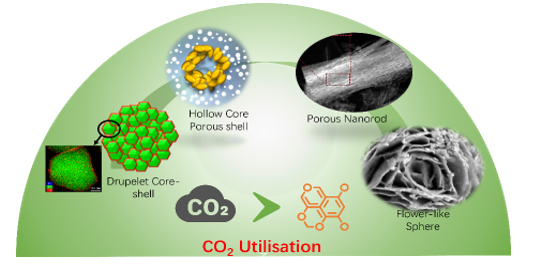Video Article Open Access
Nanostructured Nanoparticles for CO2 Utilisation
Jeannie Z. Y. Tan*, M. Mercedes Maroto-Valer
Research Centre for Carbon Solutions (RCCS), Heriot–Watt University, Edinburgh EH14 4AS, United Kingdom
Vid. Proc. Adv. Mater., Volume 3, Article ID 2206290 (2022)
DOI: 10.5185/vpoam.2021.06290
Publication Date (Web): 12 Sep 2022
Copyright © IAAM
Graphical Abstract

Abstract
Nanomaterials have attracted enormous attention due to their interesting properties and applications in diverse areas, including photo(electro)catalysis, nanoelectronics, and integrated catalysis. Core–shell nanostructures with conducive and versatile compositions and structures are highly desirable in certain applications as they are task–specific nanomaterials with multifunctional capabilities. Moreover, nanomaterials with synergetic properties between the core and the shell have become a very important class for emerging applications, such as enhanced optical devices, tailored magnetic materials, energy storage materials, fuel cell, dye sensitized solar cells and many important catalytic reactions. The use of advanced architectures, including porous core-shell and multi-shelled hollow micro/nanostructures, at the nanoscale has been shown to have a positive effect, enhancing photocatalytic efficiency. Over recent years, a great deal of effort has been dedicated to reducing anthropogenic CO2 concentrations. Amongst the many strategies considered for this purpose, photocatalytic conversion of CO2 and H2O is regarded as one of the most promising solutions, since it not only utilises CO2, but also generates value added chemicals, such as CO and other hydrocarbons. However, the low selectivity and conversion efficiency of CO2 photoreduction renders the process currently unviable for commercialisation. To improve the selectivity and conversion efficiency of CO2 conversion into valuable chemicals using the intermittence energy, specifically solar energy, I proposed the use of advanced nanostructured core-shell, including hollow core multi-shell, porous core hollow shell and drupelet core-shell, synthesized using the versatile solvothermal approach. State-of-the-art characterisation techniques, including in situ and operando analysis, evidenced that the performance of the synthetised materials strongly related to the nanostructures created. The uniqueness of the advanced core-shell structures has shown the advantages on the interfacial formation between the core and the shell leading to effective heterojunctions formed between the p- and n-type semiconductors. As a result, the synthesized materials can hinder the recombination of photogenerated electron-hole pairs, and thereby, enhancing photocatalytic reduction of CO2 [1]. Furthermore, the introduction of oxygen vacancy has revealed a significant enhancement in the visible light response, thus improving the electronic properties of the semiconducting materials and promoting the photoreduction of CO2 [2]. Other nanostructures, including porous nanorods and flower-like nano-spheres, have also been synthesized for CO2 photoreduction. To gain insight in this coupled physical/chemical processes and to optimise the conversion efficiency, parametric simulations (i.e., CO2 gas flow, humidity, and light intensity) were performed, and it was concluded that humidity plays a significant role in improving the performance of CO2 photoreduction [3].
Keywords
Semiconductor; photocatalysis; metal oxides; heterojunctions.
Acknowledgement
The authors acknowledge the financial support provided by the Engineering and Physical Sciences Research Council (EP/K021796/1), the Research Centre for Carbon Solutions (RCCS) and the Robert Buchan Chair in Sustainable Energy Engineering at Heriot-Watt Universit.
References
- J. Z. Y. Tan, F. Xia and M. M. Maroto-Valer, ChemSusChem, 2019, 12, 5246-5252.
- J. Z. Y. Tan, S. Gavrielides, M. Belekoukia, W. A. Thompson, L. Negahdar, F. Xia, M. Maroto-Valer and A. M. Beale, Chem. Commun., 2020, 56, 12150-12153.
- M. A. Ávila-López, S. Gavrielides, X. Luo, A. E. Ojoajogwu, J. Z. Y. Tan, E. Luévano-Hipólito, L. M. Torres-Martínez and M. M. Maroto-Valer, J. CO2 Util., 2021, 50, 101588.
Biography
Jeannie Z. Y. Tan (MRSC) is a research associate of the Research Centre for Carbon Solutions at Heriot–Watt University. She received her BSc. with Honours from The Universiti Sains Malaysia in 2010 and graduated from her MSc. (2013) from Zhejiang University with the best Master Thesis in China. She worked as a postgraduate researcher in Commonwealth Scientific and Industrial Research Organization (CSIRO) throughout her PhD study and obtained her PhD degree in 2017 from The University of Melbourne. Since she joined RCCS, she has been working on an EPSRC funded project to develop innovative solutions for solar fuel conversion; and she is currently working on an UKRI funded project to develop innovative solutions for electrosynthesis of commodity chemicals from syngas. She currently has 31 publications with accumulated citations over 800 times, authored 1 patent and contributed a book chapter. Among the published papers, 25.9% of her publications are in top 10% most cited worldwide and 56.5% of her publication are published in the journals ranked world top 10% in the subject area of Chemistry, Material Science and Engineering and Energy according to the Scimago Institutions Rankings January 2022. She is also a reviewer to a number of journals, including RSC Nanoscale Advances, ChemCatChem and ChemPhotoChem.
Video Proceedings of Advanced Materials

Upcoming Congress



